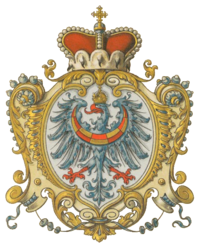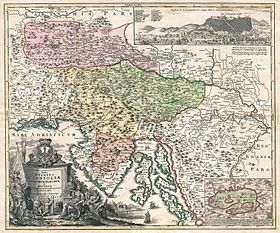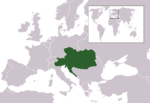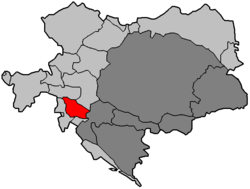- Duchy of Carniola
-
Vojvodina Kranjska (sl)
Herzogtum Krain (de)
Duchy of CarniolaState of the Holy Roman Empire (until 1806),
constituent land of the Austrian Empire and
Cisleithanian crown land of Austria-Hungary← 
1364–1918  →
→

Flag Coat of arms Duchy of Carniola within Austria-Hungary Capital Ljubljana Government Principality Historical era Middle Ages - March of Carniola
bequeathed to
House of Habsburg1335 - Raised to Duchy 1364 - Joined Austrian Circle 1512 - Ceded to
Illyrian Provinces1809 - Restored to Austria 1815 - Part of the
State of Slovenes, Croats and Serbs1918 The Duchy of Carniola (Vojvodina Kranjska, Herzogtum Krain) was an administrative unit of the Holy Roman Empire and the Habsburg Monarchy from 1364 to 1918. Its capital was Ljubljana. The duchy had an area of 3,857 square miles (9,990 km2) and population of 510,000.
Contents
History
See also: March of CarniolaAfter Duke Henry of Carinthia had died in 1335 without a male heir, his daughter Margaret only was able to keep the County of Tyrol, while Emperor Louis IV of Wittelsbach passed the Duchy of Carinthia together with the Carniolian march to the Austrian duke Albert II von Habsburg. His son Rudolf IV awarded himself the title of a "Duke of Carniola" in 1364. After his death as a result of the quarrels between his younger brothers Albert III and Leopold, Carniola by the 1379 Treaty of Neuberg became part of Inner Austria ruled from Graz by Leopold, ancestor of the Habsburg Leopoldian line. In 1457 the Inner Austrian territories were re-united with the Archduchy of Austria under the rule of Emperor Frederick III of Habsburg. When Frederick's descendant Emperor Ferdinand I of Habsburg died in 1564, Carniola was separated again as part of Inner Austria under the rule of Ferdinand's son Archduke Charles II. Charles' son Emperor Ferdinand II of Habsburg in 1619 inherited all the dynasty's lands and the duchy formed a constituent part of the Habsburg Monarchy ever since.
 Coat of arms of Carniola, Hugo Gerhard Ströhl
Coat of arms of Carniola, Hugo Gerhard Ströhl
Napoleon subsequent to the 1809 Treaty of Schönbrunn formed the short-lived Illyrian Provinces from the annexed territories in Carniola, Carinthia, Croatia, Gorizia and Gradisca, and Trieste. The Final Act of the 1815 Congress of Vienna restored the Illyrian Provinces to the Austrian Empire. Carniola then formed the central part of the territory of the Habsburg Kingdom of Illyria whose capital was also Ljubljana. It was bounded on the north by the Duchy of Carinthia, on the north-east by the Duchy of Styria, on the south-east and south by Kingdom of Croatia and Slavonia, and on the west by the County of Gorizia and Gradisca and Istria.
After the disestablishment of the Illyrian Kingdom in 1849, the Duchy of Carniola was constituted by rescript of 20 December 1860, and by imperial patent of 26 February 1861, modified by legislation of 21 December 1867, granting power to the home parliament to enact all laws not reserved to the imperial diet, at which it was represented by eleven delegates, of whom two elected by the landowners, three by the cities, towns, commercial and industrial boards, five by the village communes, and one by a fifth curia by secret ballot, every duly registered male twenty-four years of age has the right to vote. The home legislature consisted of a single chamber of thirty-seven members, among whom the prince-bishop sits ex-officio. The emperor convened the legislature, and it is presided over by the governor. The landed interests elected ten members, the cities and towns eight, the commercial and industrial boards two, the village communes sixteen. The business of the chamber was restricted to legislating on agriculture, public and charitable institutions, administration of communes, church and school affairs, the transportation and housing of soldiers in war and during manoeuvres, and other local matters. The land budget of 1901 amounted to 3,573,280 crowns ($714,656).
In 1918, the duchy ceased to exist and its territory became part of the newly formed State of Slovenes, Croats and Serbs and subsequently part of the Kingdom of Serbs, Croats and Slovenes (from 1929 called Kingdom of Yugoslavia). The western part of the duchy, with the towns of Postojna, Ilirska Bistrica, Idrija, Vipava and Šturje was annexed to Italy in 1920, but was subsequently also included into Yugoslavia in 1945.
 Historic map of the Carniolan duchy: Upper (pink), Lower (green) and Inner (yellow) Carniola with adjacent March of Istria (orange), Johann Homann, 1714
Historic map of the Carniolan duchy: Upper (pink), Lower (green) and Inner (yellow) Carniola with adjacent March of Istria (orange), Johann Homann, 1714
Administrative divisions
Carniola was traditionally divided into three sub-regions: Upper Carniola (Slovenian name: Gorenjska, German: Oberkrain), Lower Carniola (Slovenian: Dolenjska, German: Unterkrain), and Inner Carniola (Slovenian: Notranjska, German: Innerkrain). Until 1860, these sub-regions coincided with the districts (Kreise) of Ljubljana, Novo Mesto and Postojna. They were later divided into smaller units, called political (or administrative) districts. Between 1861 and 1918, Carniola was divided into eleven districts consisting of 359 municipalities, with the provincial capital serving as the residence of the imperial governor (Landeshauptmann). The districts were: Kamnik, Kranj, Radovljica, the neighbourhood of Ljubljana, Logatec, Postojna, Litija, Krško, Novo Mesto, Črnomelj, and Kočevje. The political districts were in turn divided into 31 judicial circuits.
Demographics
1846
In 1846, population of Carniola included:[1]
1910
In 1910, population of Carniola included:[2]
Coat of arms and flag
The coat of arms of the Duchy of Carniola dates back to the 13th century, when it most probably evolved as a combination of the coats of arms of the noble houses of Andechs-Merania (eagle) and Sponheim (red-white checkerboard). In 1463 Emperor Frederick III added the golden crown to the eagle and replaced the white in the shield and the checkered crescent with gold. In 1836 Emperor Ferdinand I of Austria restored the original white color to the shield and recognized the white-blue-red combination as the official Carniolan color scheme.
Under the Habsburg rule the white, blue and red from the Carniolan coat of arms (the shield, the eagle and the crescent) were confirmed as the official flag colors of the crownland in 1848. Since the Duchy of Carniola was the main Slovene-populated region of the Austrian Empire, the color scheme was subsequently accepted as the generic Slovene national tricolor by the inhabitants of other Slovene Lands.
As for the coat of arms, it was abandoned after 1918 with the passing of the Duchy of Carniola. The blue eagle of Carniola was, however, briefly resurrected from 1943 to 1945 as the symbol of the Slovenian auxiliary Axis forces, the Slovene Home Guard. It was also used in the Yugoslav House of Karađorđević coat-of-arms in the interwar period (and was replaced in the state coat-of-arms of the Kingdom of Yugoslavia by the three stars of the medieval Counts of Celje).
The insignia of the Duchy of Carniola have had an important and lasting impact on Slovene national symbols. Thus, the white-blue-red combination of the flag of the Duchy of Carniola is in use today as the official color scheme of the flag of the Republic of Slovenia. The Slovenian coat of arms is also a heraldic composite, incorporating the stars of the Counts of Celje, the Carniolan colors and the image of the Slovene holy mountain Triglav.
History of Slovenia 
This article is part of a seriesNoricum/Pannonia Slavic settlement of the Eastern Alps Samo's Realm Carantania Carniola Holy Roman Empire March of Carniola Windic March Illyrian Provinces Kingdom of Illyria Duchy of Carniola Drava Banovina Province of Ljubljana Socialist Republic of Slovenia Republic of Slovenia
Slovenia Portal
Dukes of Carniola
- Rudolph (1364–1365), also Duke of Austria since 1358, followed by his brothers
- Albert (1365–1379), jointly with
- Leopold (1365–1386), progenitor of the Habsburg Leopoldian line, sole Duke of Inner Austria after the 1379 Treaty of Neuberg
- William (1386–1406), son of Leopold, followed by his brother
- Ernest the Iron (1406–1424), Archduke from 1414
- Frederick (1424–1493), son of Ernest, King of the Romans from 1440 and Holy Roman Emperor from 1452, also Archduke of Austria from 1457
- Maximilian I (1493–1519), son, also Archduke of Austria, Holy Roman Emperor from 1508
- Charles I (1519–1521), grandson, also Archduke of Austria, Emperor-elect from 1520, followed by his brother
- Ferdinand I (1521–1564), also Archduke of Austria, King of the Romans from 1531, Holy Roman Emperor from 1558
- Charles II (1564–1590), son of Ferdinand, Archduke of Inner Austria upon second partition of the Habsburg lands
- Ferdinand II (1590–1637), son, also Archduke of Austria and Holy Roman Emperor from 1619
Heir of all Habsburg lines in 1619. See List of rulers of Austria
See also
References
External links
 Austrian Circle of the Holy Roman Empire
Austrian Circle of the Holy Roman Empire Habsburg lands
Habsburg lands
Prince-Bishoprics  Teutonic bailiwicksAn der Etsch · Austria
Teutonic bailiwicksAn der Etsch · AustriaProvinces of the Austrian Empire Kingdom of Bohemia · Kingdom of Hungary · Kingdom of Illyria · Kingdom of Dalmatia · Kingdom of Croatia-Slavonia · Kingdom of Galicia and Lodomeria · Kingdom of Lombardy and Venetia · Archduchy of Austria · Duchy of Carinthia · Duchy of Carniola · Duchy of Salzburg · Duchy of Upper and Lower Silesia · Duchy of Styria · Duchy of Bukovina · Voivodeship of Serbia and Banat of Temeschwar · Grand Principality of Transylvania · Margraviate of Moravia · Princely County of Tyrol with Vorarlberg · Austrian Littoral (Princely County of Gorizia and Gradisca · Margravate of Istria · Imperial Free City of Trieste) · Military Frontier

 Slovenia topics
Slovenia topicsHistory Timeline · Noricum/Pannonia · Slavic settlement of the Eastern Alps · Samo's Realm · Carantania · March of Carniola · Windic March · Illyrian Provinces · Kingdom of Illyria · Duchy of Carniola · Drava Banovina · Socialist Republic of SloveniaPolitics President · Prime Minister · Parliament · National Council · National Assembly · Court of Audit · Political parties · Elections · Constitution · Constitutional Court · Law · Judiciary of Slovenia · Foreign relations · Human rights (LGBT rights)Geography Statistical regions · Municipalities · Cities · Conservation · Districts and places · Fauna · Flora · Islands · Lakes · Mountains · Parks · Reservoirs · Rivers · Waterways · Urban planningEconomy History · Taxation · Ministry of the Economy · Companies · Banks · Bank of Slovenia · Ljubljana Stock Exchange · International rankingsDemographics Slovenes (list) · Slovene language · Education · Hungarians · Italians · Croats · Serbs · Macedonians · Roma in Slovenia · Jews in Slovenia · The Erased · Religion · Human rights · Social issuesCulture Transport Roads · Ljubljana Jože Pučnik Airport · Adria Airways · Buses · Driving · Rail · Aviation · Port of KoperMedia Radio · Magazines · Newspapers · Television · Media companies · Slovenian Press Agency · Internet domainSymbols Other topics  Category ·
Category ·  Portal ·
Portal ·  WikiProjectCategories:
WikiProjectCategories:- States and territories established in 1364
- States and territories disestablished in 1918
- 1918 disestablishments
- Carniola
- States of the German Confederation
- Kingdoms and countries of Austria-Hungary
- Former Slavic countries
- Rudolph (1364–1365), also Duke of Austria since 1358, followed by his brothers
Wikimedia Foundation. 2010.

